Kotak Rural Opportunities Fund NFO: Invest in Rural India growth opportunities
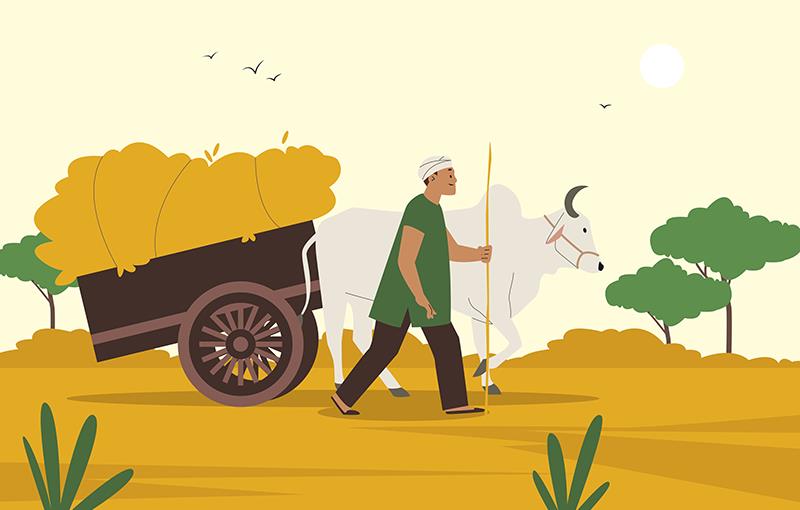
For decades, rural India was viewed as a seasonal contributor to the economy dependent on monsoons, subsidies, and sentiment. But today, Bharat is undergoing a quiet transformation. Roads are being built where there were none. Digital payments are replacing cash in remote villages. Aspirations are rising faster than inflation. This is not a flash in the pan. It is a structural shift. Bharat is catching up with India, and in some pockets, even leading. The rural economy is no longer trailing behind; it’s setting the pace. The story of Bharat is not just about consumption; it is about contribution. It is not just about upliftment; it is about empowerment.
The Kotak MF has launched the Kotak Rural Opportunities Fund NFO. The NFO has opened for subscription on 6th November and will close on the 20th of November. In this article we will review the fund and understand how this fund can be a good addition to your portfolio.
The changing face of rural India
India’s rural sector is undergoing a transformation, driven by infrastructure development, rising incomes, and government initiatives. Approximately 7.83 lakh km of rural roads has been built in India, improving connectivity and access to markets. Rural demand growth has outpaced urban demand for six consecutive quarters, from March 2023 to June 2025. Mobile data usage in rural areas grew at double the rate of urban users between 2021 and 2024. Rural e-commerce volumes surged, quadrupling during Big Billion Days 2025 compared to vs metros' double.
Economic and Social Drivers
Rural consumption accounts for 55% of India’s total private consumption, making it a critical driver of the country’s growth. India ranks among the top five global manufacturing countries, with a $781 billion output, creating rural job opportunities and boosting infrastructure. There has been a gradual shift from agriculture to non-agricultural jobs, with non-agriculture employment reaching 40.2% in 2024. Government spending on rural development is projected at over Rs 1900 billion in 2026, supporting initiatives like free health insurance for 41 crore people and 100% village electrification.
Social Progress and Income Growth
Literacy rates in rural areas have doubled to about 78% since 1991. The rural female workforce increased from 54 million in 2018 to 118 million in 2024, with dual-income households rising from 22% to 42% in the same period. Rural per capita income crossed the $2000 mark in 2024, signalling the start of a consumption take-off. The share of food in rural expenditure has decreased, with increased spending on medical and durable goods.
What role does manufacturing play in rural growth?
- Creates rural job opportunities
- Provides rural families with steady income beyond farming
- Introduction to technology & training, makes workers more skilled
- Factory growth improves rural roads, electricity & water supply
- Helps small towns grow & reduces migration to big cities
- Higher rural incomes mean more spending on goods & services
Why Invest in rural theme?
Rural development, is an important component of the long-term secular India Growth Story. The rural development theme will both be a driver and a beneficiary of industrial and economic growth of India. Changes in the rural sector evident in the long-term structural growth brought about by government policies and initiatives has the potential to build wealth for the investors over the long term. The development in the rural sector can be seen in the following points-
Shift In employment
A gradual shift from agriculture to non-agricultural jobs is observed, with non-agriculture employment at 40.2% in 2024.
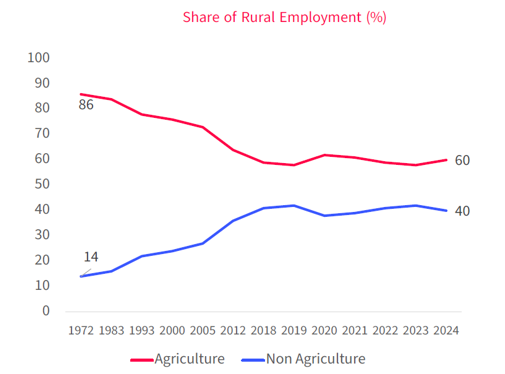
Source: CSO, PLFS Morgan Stanley Research | As per latest data available | Sector wise share data is a per Financial Year 2024
Government's rural development initiatives
There has been a significant increase in rural development spending over the years, with a projected at over Rs 1900 billion in 2026.
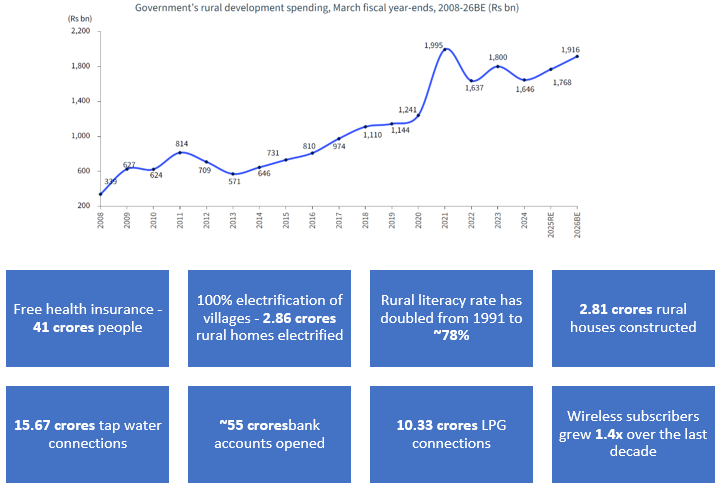
Source: Ministry of Finance, Expenditure Budget, Kotak Institutional Equities | As per latest data available
Increase In Female Workforce
- The rural female workforce increased from 54 million in 2018 to 118 million in 2024.
- Dual-income households in rural areas rose from 22% in 2018 to 42% in 2024.
Growth in Rural Income
Rural per capita income crossed the $2000 mark in 2024, indicating a starting point for consumption take-off.
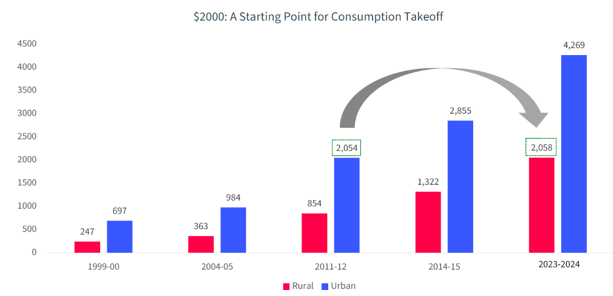
Source: Spark Capital Research. As per latest data available
Share Of Discretionary Spending
The share of food in rural expenditure has decreased, with non-food spending on the rise, particularly in medical and durable goods.
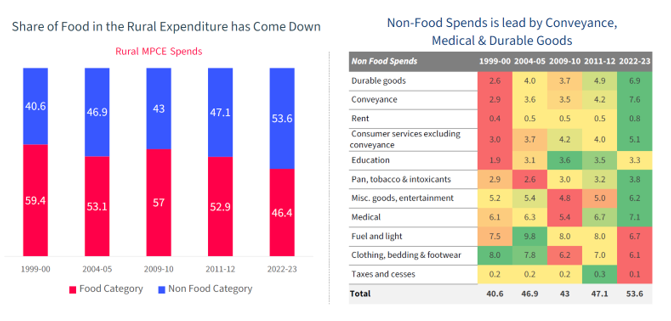
Source: Morgan Stanley. MPCE: Monthly Per Capita Consumption Expenditure. MPCE is household monthly consumption expenditure ÷ household size. This measure serves as the indicator of the household's level of living. As per latest data available
Why invest in rural opportunities now?
The markets post the GST rate cuts is an opportune time to invest in the rural sector with reduced prices. Good monsoon leading to good agri output and government support.
- Short-Term Triggers: 81% of the country received normal or excess rainfall, boosting agricultural output and rural incomes. Agricultural produce is on the rise, with significant growth in various crops.
- Agricultural output has been on a rise

Source: https://upag.gov.in
- Rural demand continues to be positive

Performance of the Nifty Rural Index
The Nifty Rural Index has outperformed the Nifty 500 Index since inception, indicating strong rural market performance.
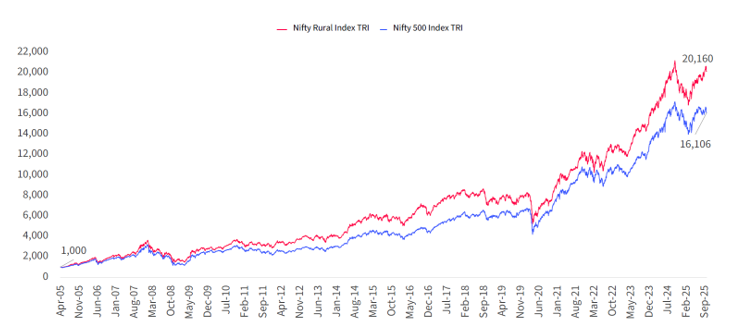
Source: ICRA, Data as of 30th September 2025 | Date of Inception of Nifty Rural Index : 1st April 2005
Kotak Rural Opportunities Fund NFO
The Kotak Rural Opportunities Fund NFO, an open-ended equity scheme, presents a compelling opportunity for investors looking to capitalize on the growth potential of rural India. Mr. Arjun Khanna will be manager for Equity and Overseas investment of the Scheme. Mr. Abhishek Bisen will be the Fund Manager for debt investment of the Scheme. With strong economic and social drivers, coupled with government initiatives and favourable market conditions, this fund is well-positioned to deliver attractive returns over the long term.
Investible universe

Investment Philosophy
The fund managers shall employ a bottom-up approach for stock selection, focusing on companies with growth potential in rural India. This fund focuses on companies driving rural growth across sectors such as agriculture, manufacturing, and services. The fund is market cap agnostic, diversified across large, mid, and small caps.
Why invest in Kotak Rural Opportunities?
- The Kotak Rural Opportunities Fund offers exposure to the long-term structural trends and short-term triggers driving rural growth in India.
- By investing in companies linked to rural development, the fund aims to benefit from the increasing rural demand, rising incomes, and government support.
- The diversified approach across market caps and sectors reduces risk and enhances the potential for returns.
Who should invest in this NFO?
- Investors who want to supplement their core portfolio with a thematic fund.
- Investors seeking to invest in rural and allied theme
- Investors who want capital appreciation over long investment tenures
- Investors with very high risk appetites
- Investors with minimum 5 year investment horizon.
Investors should consult a mutual fund distributor or financial advisor to understand if the Kotak Rural Opportunities Fund NFO is suitable for them.
Mutual Fund Investments are subject to market risk, read all scheme related documents carefully.
Established in 1985 by Mr. Uday Kotak, it was the first Indian non-banking financial company to be given a banking licence by the Reserve Bank of India in February 2003.The group caters to the financial needs of individuals and institutional investors across the globe. Kotak Mutual Fund is the wholly-owned subsidiary of Kotak Mahindra Bank Limited. Kotak Mutual Fund started its operations in December 1998 and is now the 5th largest AMC based on quarterly Average AUM as of December 2020.
Investor Centre
Follow Kotak MF
More About Kotak MF
POST A QUERY











